| Columns Retired Columns & Blogs |
$7000 computer speakers connected via $20,000 worth of digital cables. Abundant software glitches. Lacking in sound. Still "deserve an extended audition." In other words one of the brands that always gets a pass.
I used DRA Labs' MLSSA system and a calibrated DPA 4006 microphone to measure the Dynaudio Focus 200 XD's frequency response in the farfield; and, for the nearfield frequency responses, an Earthworks QTC-40, which has a ¼" capsule and thus doesn't present a significant obstacle to the sound.
I measured the Dynaudio at its analog input. As the Focus 200 XD is a powered speaker, my estimate of its voltage sensitivity can't be directly compared with those I publish for conventional speakers. But with a pink-noise input at 115mV RMS, the 200 XD's rotary Speaker Position knob set to Neutral, its Treble switch set to 0dB, its sensitivity switch set to its central, 0dB position, and the volume control set to its maximum with the wireless remote control, the SPL at 1m was 88.5dB(C). This increased and decreased by 5.6dB when this last switch was set to +6dB and –6dB, respectively.
The 200 XD's enclosure was extremely inert with the knuckle-rap test, and when I examined the individual panels' vibrational behavior with a plastic-tape accelerometer, all I could find was a low-level mode at 59Hz (fig.1). Though this is suspiciously close to the AC mains frequency, I couldn't find any grounding problem that might give rise to hum—and I heard none.
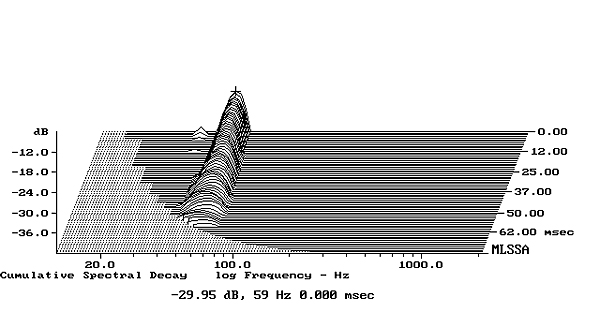
The black trace below 300Hz in fig.2 shows the complex sum of the nearfield responses of the woofer (blue) and rear-panel port (red), taking into account acoustic phase and the different distances of each from a nominal farfield microphone position. The sharply defined notch in the woofer's output at 42Hz suggests that this is the port's tuning frequency; the port's output peaks sharply between 30 and 70Hz, and though there are a couple of resonant modes evident between 400Hz and 1kHz, these are well down in level and shouldn't have audible consequences. Some of the boost in the upper bass in the summed response (black trace) will be due to the nearfield measurement technique, which assumes that the woofer and port are mounted in a flat baffle that extends to infinity in both planes. But the shape of the curve, and the >12dB/octave rolloff of both woofer and port below the port resonance frequency, imply that the Focus 200 XD's bass alignment is actually assisted with some bass boost.
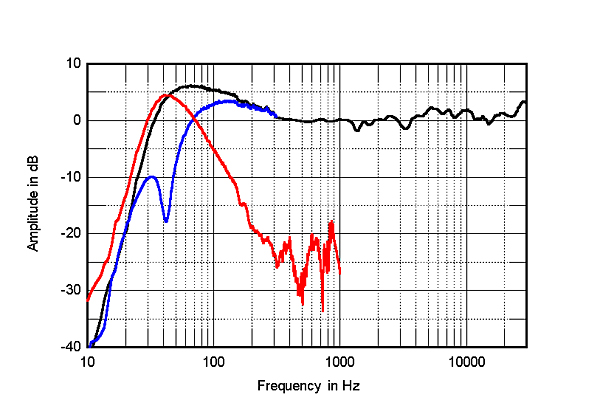
The black trace above 300Hz in fig.2 shows the Dynaudio's farfield anechoic response averaged across a 30° horizontal window centered on the tweeter axis. Other than a slight lift in the mid-treble, the response is superbly flat, meeting limits of +2.3/–1.8dB from 300Hz to 30kHz. This graph was taken with the Treble switch set to 0dB. The +1dB position raised the level above 2kHz by 0.5dB, and the –1dB position lowered the level by 1dB.
The 200 XD's horizontal dispersion (fig.3) is textbook in nature, with an even, well-controlled radiation pattern up to 10kHz or so, above which the speaker's output falls off more rapidly to the sides, as is typical of a 1" dome tweeter. In the vertical plane (fig.4), a suckout at the crossover frequency begins to develop 10° below and 20° above the tweeter axis, suggesting that listeners should sit with their ears close to or on the tweeter axis.
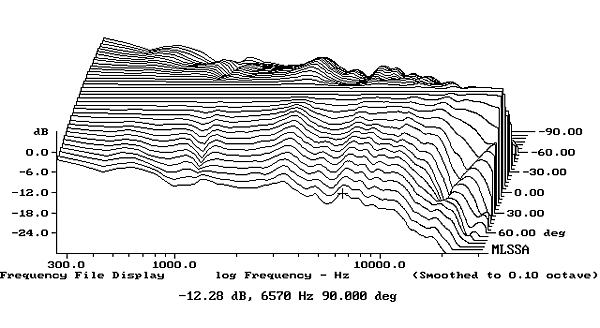
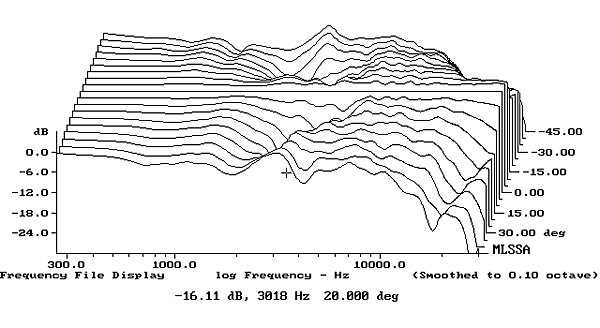
As I measured the Dynaudio at its analog input, which is subsequently digitized, I wasn't surprised to discover a latency of some 4ms between input and output. This can be seen in the speaker's step response at 50" (fig.5), where, instead of starting at around the 3.5ms mark, this corresponding to the distance divided by the speed of sound, the step begins closer to 7.5ms. But note the step's perfect right-triangle shape—to produce time-coincident arrivals of the drivers' outputs, the Dynaudio corrects for the fact that its tweeter's acoustic center is closer to the microphone than its woofer's. The cumulative spectral-decay plot (fig.6) features a superbly clean initial decay.
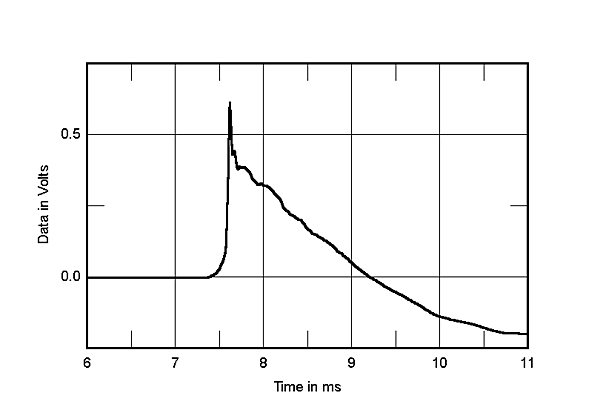
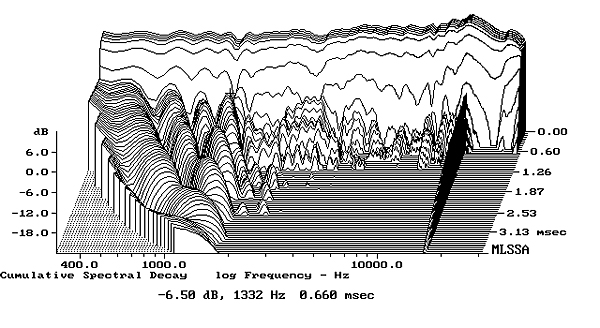
To optimize its acoustic performance in both time- and frequency-domains, Dynaudio has made use of the fact that the Focus 200 XD is a powered speaker with both digital and analog inputs and DSP. Its measured performance is, in a word, superb.—John Atkinson

$7000 computer speakers connected via $20,000 worth of digital cables. Abundant software glitches. Lacking in sound. Still "deserve an extended audition." In other words one of the brands that always gets a pass.

They sounded fabulous in my class today, and worked without a hitch. In retrospect, I think some of the connection issues had to do with the M2Tech USB to coax adapter, which tends to lose its connection to my laptop when it isn't well-supported. Since I've taken my laptop off equipment supports, and simply rested it on a Symposium platform, the speakers have worked flawlessly every time I've used them.
A reminder that, as opposed to other publications, Stereophile reviewers always list the problems they have with gear. We cover nothing up, including our set-up frustratons and, as I review this post, our spelling errors. It's "frustrations."
There is no reason why anyone has to use $20,000 worth of digital cables to get these speakers to sing beautifully. But good Lord, if you've got the cabling on long-term loan, and it sounds far, far better that the stock stuff, why not enjoy it and use it in a review to hear everything a component can produce?

My, my. Looks like benro struck a nerve. Methinks thou dost protest too much.

I bought a pair of these in 2017 and had nothing but problems - electrical connection problems. After pleading with Dynaudio for no less than 8 months, they finally replaced that pair with a pair of the Focus 20XD (the models that replaced the problematic 200 XDs), and this pair has the exact same electrical glitches! The warranty people will not even respond to emails since March! Steer clear of Dynaudio!

This is a tough one, Bob, simply because the review was written months ago, and most of my listening of late has been confined to either Tidal streamed wirelessly (inherently compromised) or, in the vocal music class I taught today, to redbook quality transfers of very old recordings. The system is very revealing, but I would never pretend a small two-way can convey all the undertones and complexity of a full-range loudspeaker system. (Then again, this speaker is at the bottom of the Focus XD line. This leads me to expect that the others do a better job.) At the same time, we had no problem catching every nuance of shading and dynamics that tenor Tito Schipa recorded in 1932, nor differentiating his performance from one by Juan Diego Florez on DVD. It was easy to hear how beautifully Schipa caressed and spun his tone, how bright Florez's voice is, and, in the case of a 1907 recording by baritione Giuseppe de Luca, how much warmth he conveys in the center of his voice. Just wonderful.
Sometimes I think people put too much emphasis on discussions of transients and microdynamics, as though hearing them somehow earns them bonus points in the knowledgable audiophile department. Sure, I hear a range of different colors, as well as the undertones and overtones in a voice through these speakers. In fact, I noticed today, when listening to a transfer on Nimbus Prima Voce label, how much body the light and charming Amelita Galli-Curci had to her voice. This is on an acoustic recording (pre-1925), mind you. Having said that, the review includes the example of what was missing from the reproduction of a hi-rez file of Callas' voice.
Ultimately, I think I am most concerned with the emotional impact of the music - its ability to touch me - and a component's ability to leave me feeling satisfied. On that score, I was smiling at the end of the class, that's for sure, and all of my students left elated. When a speaker system can do that for me, I give it a major thumbs up.

Sure thing, Active is the way to go!
You could've had Genelec , Focal or quite a few others but these DynAudio are fine.
I sold the Meridian Actives in the 1980s, they were superb and still are but not loved by "genuine" audiophiles who need infinite options and are afflicted with excessive Neurosis & Psychosis.
Actives are simple, clean solutions to very complex problems, I love em.
Recording Engineers love these things for their accuracy, the Mastering guys still prefer stuff like Revel.
Denmark make Superb Actives!!!
Nice choice in loudspeakers, I continue to discover more things to admire about you. Well done!
Tony in Michigan

I just learned that L.Bernstein finally got around to doing an Operatic version of West Side Story, on Polygram, around 1985ish.
Can you offer an opinion on the recording?
It's rather hard to find a CD copy but some are on eBay for $5. I don't have one but will buy if you green light it.
Rather nice to get those Loooooooong Term loaners, I used to get Cars and I know our "Fav" Car reviewers all got em. Travel Reviewers get Free ( 1099'd ) Trips.
Do your Reviewers get Free Singing Lessons?
Tony in Michigan

I just learned that L.Bernstein finally got around to doing an Operatic version of West Side Story, on Polygram, around 1985ish. Can you offer an opinion on the recording?
I am sure Jason will offer his opinion, but I feel this is a dreadful recording, not the least because of the miscasting of Jose Carreras as the anglo lead Tony. Stick with the original cast recording (Broadway, not movie,in my opinion).
There is a notorious documentary available on the making of this recording. Well worth watching.
John Atkinson
Editor, Stereophile

The recording was a mistake. And to see Lenny yelling at poor José, berating him for his pronunciation when in fact it was Bernstein's mis-judgment that cast him in the first place, is quite the eye opener. Stick with the documentary.

I'm a little worried why Jason (the reviewer) has termed the amps inside to be PWM, which is technically correct, but for those not informed, these are Class D amps and I believe should be worded as such, as there are many amongst us that give Class D a wide berth.
Cheers George

Hello George. A technical whiz I am not. That I will leave to JA. But what I can tell you is that simplifying matters by calling these amplifiers Class D does not begin to explain what they are.
Portions of my review needed to be cut for space considerations. Here is more information on these speakers:
As stated in Dynaudio’s literature, the Focus 200 XD’s PWM (Pulse Width Modulation) amplification “negates the need for a separate DAC, as all signals are processed digitally in the amplifier without analogue conversion, and remain in the digital domain until the latest possible and most ideal moment – right at the output at the drivers.” When I questioned Dynaudio USA’s Michael “Mike” Manousselis and Mick Tillman about this technology, they sent me a 15-year old, 20-page white paper [http://www.ti.com/lit/ds/sles006a/sles006a.pdf] that describes Texas Instruments’ True Digital Audio Amplifier (TDAA) and TAS5015 Digital Audio PWM Processor.
In his accompanying email, Mike wrote, “Really, the first page is a good explanation of the technology platform.” Mick Tillman of Dynaudio USA even was more direct when he told me that the information is extremely technical, and most people stop after the first page because they aren't equipped to make sense of what follows. I was extremely grateful for this advice, because when I searched Google for “TDAA,” the first thing that came up was “Teacup Dogs Agility Association.” Our terrorers were not impressed.
The white paper’s first page states, “The true digital audio amplifier (TDAA) is a new paradigm in digital audio. One TDAA system consists of the TAS5015 PCM-PWM modulator device plus a discrete back-end TDAA power output. This system accepts a serial PCM digital audio stream and converts it to a 3.3-V PWM audio stream (TAS5015). The discrete back-end TDAA then provides a large-signal PWM output. This digital PWM signal is then demodulated, providing power output for driving loudspeakers. This patented technology provides low-cost, high-quality, high-efficiency digital audio applicable to many audio systems developed for the digital age. The TAS5015 is an innovative, cost-effective, high-performance 24-bit stereo PCM-PWM modulator based on Equibit technology. The TAS5015 has a wide variety of serial input options including right-justified (16, 20, or 24 bits), IIS (16, 20, or 24 bits), left-justified (16 bits), or DSP (16 bits) data formats. It is fully compatible with AES standard sampling rates (Fs) of 44.1 kHz, 48 kHz, 88.2 kHz, 96 kHz, 176.4 kHz, and 192 kHz. The TAS5015 also provides a de-emphasis function for 44.1-kHz and 48-kHz sampling rates.” It gets far more complex from there.
I will leave it to JA to comment further, if he feels called to do so.

The descriptor Class D amplifier is often misunderstood, and the review is basically communicating the 'exact' type of amplifier that is used in the Focus XD.

At least these speakers, with their built-in power supply answer a long vexing question to those of us who love the Dynaudio sound but harbor deeper concerns: will I have to buy a new amplifier to support these speakers?
I recently had an opportunity, in a dealer show, to sample the other spin-off of the Focus 160 (of which this model under review is the more luxurious). I was able to sample this other successor of the Focus 160 with the successor model of my own integrated amplifier.
In a rare treat, I was able to man, responsibly, the volume knob with the Dyanudio speaker connected to the equivalent of my home amplification. I loved the sound of the speakers. I was, as I feared with this brand, unnerved by how much more I had to turn up the volume knob to get an appreciable volume out of the speakers.
Yes, watts/channel -vs- current/stability, I've heard it all before, though I would not claim to be the world's expert on the subject. This brand of speaker requires watts per channel if you listen to music with low sound level passages (a'la Murray Perahia's/Radu Lupu's Schubert Impromptus, Kissin's Rachmaninov 3rd Concert, Emil Gilels' sampling of Grieg's Lyric Pieces).
Moreover, now that I'm trying to become a more diligent student of JA's measurements and bottom line assessments of integrated amps, I learn that ("see your dealer" exhortations aside) many models, even among the "recommended components," are probably in the "don't try this at home" category for this brand of speaker.
Perhaps, getting back to the main point, this self-powered unit puts to rest the question of how to match amplification with these speakers. If you buy some Wilsons, you know what you are signing up for in the amplification realm. With this brand--and it's sad since the products sound so good--it's a murkier proposition to knowing what you may need to buy to power this brand of speakers.
According to the manufacturer's site, newer models are more "amplifier friendly." With my hand on the knob test, the second greatest test after "trust your ears," I found little amplifier friendliness.

They are either Linear amps or they're Class D amps inside. I think Class-D
https://en.wikipedia.org/wiki/Class-D_amplifier
Cheers George

I have heard some lovely class D amps at recent shows.

Audiophiles are the only ones that worry about Class D.
The Focal Actives use Class AB, I think. A few others too.
However the World's leading Actives ( Genelec ) are Class D.
We are at the point where most of the Recording Studios use Class D Amplification.
Hi-End Audiophiles are the hold out, clinging to Class A ( even I still own and use a Class A Amp ) but we're willing to spend mega bucks to get it. I'm not certain it's worth the expense, the Class D stuff is brilliant.
Still, the Focal Be6 is Class AB with heat Fins along the back, about the same price, it's rather industrial looking, by comparison.
Performance should be the issue, not Amp Class.
Tony in Michigan

Years ago, in my pre-Stereophile era, I had to review an early Class D amp. I hated the sound so much that I stalled on the review for months, not knowing what to do. Every time I put the thing in my system, the sound was so flat and lifeless that I couldn't wait to remove it. I certainly couldn't sit through an entire symphony.
But that was over a decade ago. The technology has improved. The analogy of baroque violin performance, which went from squeaky irritating to glorious, is appropriate here. Class D implementation may not have yet reached its Golden Age, but it need no longer serve as a warning to music lovers to stay away.

I think we're heading into a new World and Age, Class D is part of it.
LED lighting is another part.
Head-Fi has a very popular thread covering the V10 Audiophile Phone. Headphone audiophiles are describing it's musical abilities in complimentary ways, comparing it to the Chord Mojo, for god's sake. Focal introduced the Utopia headphone that needs only a few milliwatts ( on Stereophile's Front Cover ).
The Big Amps & Preamps we see (today) at Audiophile Shows reminded me of my Ham Radio days ( 1950s ), full of tubes and making plenty of heat. Those were wonderful memories from 70 years ago.
Friday ( two days ago ) waiting for a Flight, I was watching & listening to Hilary Hahn playing "Live" at the Detroit Symphony O . I was enabled by a pocketable ( and highly portable ) Music System, I could've been nearly anywhere.
Your Tyll will be at RMAF ( next weekend ) doing Seminars on the Future of headphones!, I think he'll be describing the Future of Consumer level Music reproduction gear.
Things are moving quite fast now, there's a tremendous amount of intellegent energy being released to discover new solutions to age old problems, I'll be here reading your reporting of it.
Bon Voyage,
Tony in Michigan

"But that was over a decade ago. The technology has improved. The analogy of baroque violin performance, which went from squeaky irritating to glorious, is appropriate here. Class D implementation may not have yet reached its Golden Age, but it need no longer serve as a warning to music lovers to stay away."
In this case, TI's press release announcing their then-new TAS5015 was dated March 30, 2001, which was more than 15 years ago. There was and is nothing very wrong with the TAS5015 in consumer audio applications, if used in a well engineered design that accomodates its moderately low PSRR. TI has since come out with many newer chipsets. 15 years is rather old for a mixed signal processing chipset, and TI no longer recommends using this one in new designs, though they still do continue to provide support for it.